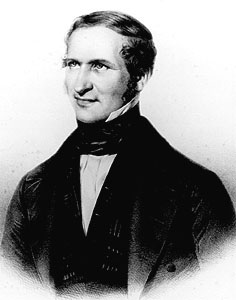Gustav Rose facts for kids
Quick facts for kids
Gustav Rose
|
|
|---|---|
 |
|
| Born | 18 March 1798 |
| Died | 15 July 1873 (aged 75) |
| Known for | Meteorite classification |
| Scientific career | |
| Fields | Mineralogy Meteorites |
| Thesis | De Sphenis atque titanitae systemate crystallino (1820) |
| Academic advisors | Christian Samuel Weiss Jöns Jacob Berzelius |
| Notable students | Karl Friedrich August Rammelsberg Gerhard vom Rath Paul Heinrich von Groth Alexander Sadebeck |
Gustav Rose (born March 18, 1798 – died July 15, 1873) was a famous German mineralogist. He was born in Berlin. A mineralogist is a scientist who studies minerals.
Gustav Rose was also the president of the German Geological Society. He held this important position from 1863 until his death in 1873.
Contents
About Gustav Rose
Gustav Rose was born in Berlin. His father, Valentin Rose, was a pharmacologist. This means his father studied medicines and how they affect the body.
His Education and Early Career
Gustav Rose went to the University of Berlin. There, he studied with a well-known mineralogist named Christian Samuel Weiss. He also traveled to Stockholm, Sweden, to learn from Jöns Jakob Berzelius. Berzelius was a famous chemist.
While studying with Berzelius, Rose met another German chemist, Eilhard Mitscherlich. They became lifelong friends. Rose helped Mitscherlich with his work on isomorphism. This is a concept where different chemical substances can have the same crystal shape.
In 1826, Gustav Rose became a professor of mineralogy in Berlin.
Adventures in Russia
In 1829, Rose went on an exciting scientific trip. He traveled across Imperial Russia with two other famous naturalists. They were Alexander von Humboldt and Christian Gottfried Ehrenberg.
During this trip, Rose studied minerals in many places. He explored the Altai Mountains and the Ural Mountains. He also studied the region around the Caspian Sea.
Later Life and Leadership
In 1856, Rose was made the director of the Royal Mineralogical Museum. This was a very important role. From 1863 until he passed away, he led the German Geological Society.
Gustav Rose's Discoveries
Gustav Rose made many important discoveries. His work helped us understand rocks and crystals better.
Studying Crystals and Minerals
Rose was very interested in crystallography. This is the study of how crystals are formed and their shapes. He was one of the first in Germany to use a special tool called a reflective goniometer. This tool helps scientists measure the angles of crystal faces very accurately.
He also studied how the shape of a crystal relates to its physical properties. He created a new system for classifying minerals. This system combined ideas from chemistry, isomorphy, and the shapes of minerals.
Research on Rocks and Meteorites
Rose studied many common rocks and minerals. These included quartz, feldspars, and granites. He also looked at the minerals found in trap rock.
He is especially remembered for his research on meteorites. These are rocks that fall to Earth from space. He studied tiny, round grains found in some meteorites called chondrules.
Rose also helped create a system to classify meteorites. This system is called the "Rose-Tschermak-Brezina classification." He worked on it with Gustav Tschermak von Seysenegg and Aristides Brezina.
New Minerals and Terms
Gustav Rose discovered several minerals that were new to science. One of these was perovskite. He named it after a Russian mineralogist, Lev Aleksevich von Perovski.
A pink-colored mineral called roselite was named after Rose himself. He also created the names for two types of meteorites: howardite and eucrite.
His Publications
Gustav Rose wrote several important books about his research.
- Elemente der Krystallographie (1830) – This book was about the basics of crystallography.
- Mineralogischgeognostische Reise nach dem Ural, dem Altai and dem Kaspische Meere (1837 Vol. 1; 1842 Vol. 2) – This described his mineralogical journey to the Urals, Altai Mountains, and Caspian Sea.
- Das Krystallo-chemische Mineralsystem (1852) – This book explained his new system for classifying minerals based on their crystals and chemistry.
His Family
Gustav Rose came from a family of scientists. His brother, Heinrich Rose, was also a mineralogist.
Gustav Rose had two sons who became famous. His son Edmund Rose became a well-known surgeon. His other son, Valentin Rose, was a classicist. This means he studied ancient Greek and Roman history and literature.
See also
- Glossary of meteoritics

